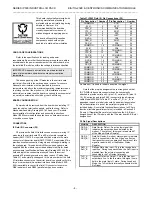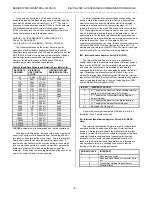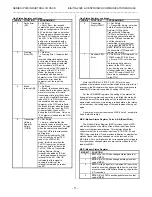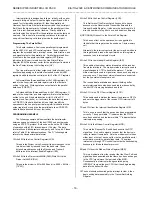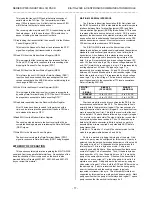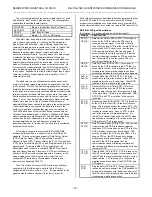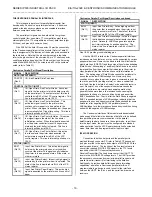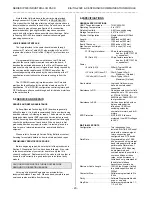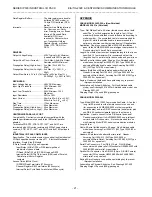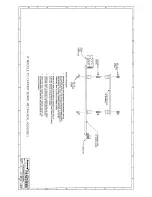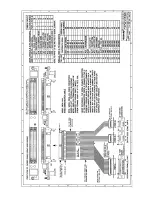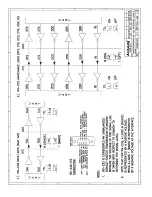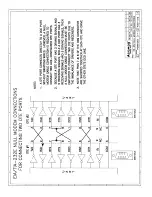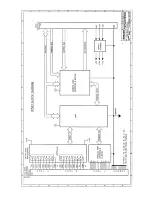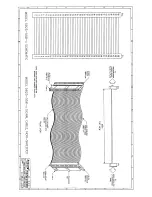
SERIES IP503 INDUSTRIAL I/O PACK EIA/TIA-232E & CENTRONICS COMMUNICATION MODULE
___________________________________________________________________________________________
- 15 -
FIFO Polled-Mode
Resetting Interrupt Enable Register Bit 0, Bit 1, Bit 2, Bit 3, or
all four to 0, with FIFO Control Register (FCR) Bit 0 =1, puts the
channel into the polled-mode of operation. The receiver and
transmitter are controlled separately and either one or both may
be in the polled mode. In FIFO-Polled Mode, there is no time-out
condition indicated or trigger-level reached, the transmit and the
receive FIFO’s simply hold characters and the Line Status
Register must be read to determine the channel status
FIFO-Interrupt Mode
In FIFO Interrupt Mode, data transfer is initiated by reaching
a pre-determined trigger-level or generating a time-out condition.
Please note the following with respect to this mode of operation
When the receiver FIFO and receiver interrupts are enabled,
the following receiver status conditions apply:
1 LSR Bit 0 is set to 1 when a character is transferred from the
shift register to the receiver FIFO. It is reset to 0 when the
FIFO is empty
2 The receiver line-status interrupt (IIR=06) has a higher priority
than the received data-available interrupt (IIR=04)
3 The receive data-available interrupt is issued to the CPU when
the programmed trigger level is reached by the FIFO. It is
cleared when the FIFO drops below its programmed trigger .
receive data-available interrupt indication (IIR=04) also
occurs when the FIFO reaches its trigger level, and is cleared
when the FIFO drops below its trigger level
When the receiver FIFO and receiver interrupts are enabled,
the following receiver character time-out status conditions apply:
1 A FIFO character time-out interrupt occurs if:
•
A minimum of one character is in the FIFO
•
The last received serial character is longer than four
continuous prior character times ago (if 2 stop bits are
programmed, the second one is included in the time
delay)
•
The last CPU read of the FIFO is more than four
continuous character times earlier. At 300 baud, and
with 12-bit characters, the FIFO time-out interrupt
causes a latency of 160ms maximum from received
character to interrupt issued
2 The time-out timer is reset after the CPU reads the receiver
FIFO or after a new character is received when there has
been no time-out interrupt
3 A time-out interrupt is cleared and the timer is reset when the
CPU reads a character from the receiver FIFO
When the transmit FIFO and transmit interrupts are enabled
(FCR Bit 0 = 1 and IER=01), a transmitter interrupt will occur as
follows:
1 When the transmitter FIFO is empty, the transmitter holding
register interrupt (IIR=02) occurs. The interrupt is cleared
when the Transmitter Holding Register (THR) is written to, or
the Interrupt Identification Register (IIR) is read. One to
sixteen characters can be written to the transmit FIFO when
servicing this interrupt
2 The transmit FIFO empty indications are delayed one character
time minus the last stop bit time when the following occurs:
Bit 5 of the LSR (THRE) is 1 and there is not a minimum of
two bytes at the same time in the transmit FIFO since the last
time THRE=1The first transmitter interrupt after changing
FCR Bit 0 is immediate, assuming it is enabled
The receiver FIFO trigger level and character time-out
interrupts have the same priority as the received data-available
interrupt. The Transmitter Holding-Register-Empty interrupt has
the same priority as the Transmitter FIFO-Empty Interrupt
Loopback Mode Operation
This device can be operated in a “loopback mode”, useful for
troubleshooting a serial channel without physically wiring to the
channel. Bit 4 of the Modem Control Register (MCR) is used to
program the local loopback feature for the UART channel. When
set high, the UART channel’s serial output line (Transmit Data
Path) is set to the marking (logic 1 state), and the UART receiver
serial data input lines are disconnected from the RxD receiver
path. The output of the UART transmitter shift register is then
looped back into the receiver shift register input. Thus, a write to
the Transmitter Holding Register is automatically looped back to
the corresponding Receiver Buffer Register. Additionally, the four
modem control inputs (CTS, DSR, DCD, and RI) are
disconnected from their receiver input paths. With modem status
interrupts enabled in the Loopback Mode, the CTS*, DSR*, RI*,
and DCD* inputs are ignored. Instead, the four modem control
outputs (DTR, RTS, OUT1, and OUT2 of the MCR Register) are
internally connected to the corresponding four modem control
inputs (monitored via the Modem Status Register), while their
associated pins are forced to their high/inactive state. Thus, in
the loopback diagnostic mode, transmitted data is immediately
received permitting the host processor to verify the transmit and
receive data paths of the selected serial channel. Further,
modem status interrupt generation is controlled manually in
loopback mode by controlling the state of the four lower order
MCR bits internally, instead of by the external hardware paths.
However, in loopback mode, no interrupt requests or interrupt
vectors will actually be served, the UART only reflects that an
interrupt is pending
Interrupt Generation
This model provides individual control for generation of
transmit, receive, line status, and data set interrupts on each of
two serial channels, and a parallel port. Each port shares
interrupt request line 0 (Intreq0) according to a unique priority
shifting scheme that prevents the continuous interrupts of one
channel from freezing out another channels’ interrupt requests
After pulling the IntReq0 line low and in response to an
Interrupt Select cycle, the current highest priority interrupt
channel will serve up its interrupt vector first. Interrupt serving
priority will shift as a function of the last port served. A unique
interrupt vector may be assigned to each port and is loaded into
the Scratchpad Register (SCR) for the serial port, or the Interrupt
Vector Register for the parallel port. The IP module will thus
execute a read of the scratchpad/interrupt vector register in
response to an interrupt select cycle. Two wait states are
required to complete this cycle




